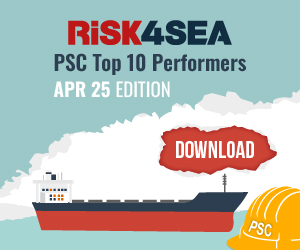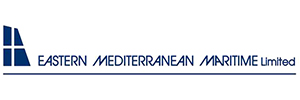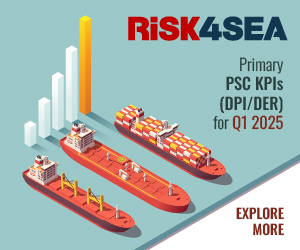Joint Maritime Information Center (JMIC) has issued an advisory outlining the current maritime security situation in the Arabian Gulf, Strait of Hormuz, and Northern Arabian Sea as of 16 June 2025, detailing regional tensions, electronic interference, and recommended precautionary measures.
As of this report dated 16 June 2025 1300 UTC, the regional threat level remains significant as strikes continue from both Iran and Israel. The maritime threat level remains ELEVATED due to uncertainty within the current environment. JMIC continue to receive reports of electronic interference stemming from the vicinity of Port of Bandar Abbas, in the SoH and several other areas in the Arabian Gulf.
UKMTO Incident Number 023-25, issued on 16 June 2025, highlights multiple reports and AIS monitoring confirming a noticeable increase in electronic interference across the Gulf and the Strait of Hormuz. These interferences, which continue to intensify throughout the region, are having significant impact within the Gulf itself. This disruption is affecting vessels’ ability to accurately transmit positional data via automated identification systems (AIS), posing operational and navigational challenges for maritime traffic. Electronic navigation equipment has also been affected.
The Strait of Hormuz remains open and commercial traffic continues to flow. While there remains a media narrative on a potential blockade of the SoH, JMIC has no confirmed information pointing towards a blockade or a closure but is closely monitoring the situation. JMIC advises companies to conduct due diligence before accepting unconfirmed media or social media reports in the maritime.
The JMIC continues to monitor the situation closely and will provide timely updates should there be any changes. Monitor the UKMTO and MSCIO website for updated information.
Daily updates will be provided unless there is a reason to provide more timely information.
1. Situation 16 June:
- Iran and Israel continue strikes focused on critical infrastructure and defensive capabilities.
- Military operations commenced early morning on 13 June 2025 to include missile strikes and drone activity. Marine operators have reported significant electronic interference in the region.
- Diplomatic efforts between the United States and Iran concerning nuclear negotiations have reportedly stalled.
- There is a possibility military operations could spill over beyond bilateral hostilities into the wider region.
- The number of transits through the Strait of Hormuz has shown a minor decrease in cargo-carrying vessels 1,000 GT and above since June 9 as follows:
- 9 June: 147
- 10 June: 135
- 11 June: 122
- 12 June: 116
- 13 June: 125
- 14 June: 113
- 15 June: 111
2. Maritime Implications:
While there are no confirmed indications of an immediate threat to maritime traffic, the following scenarios would prompt a reassessment:
- Use of ballistic or cruise missiles near major maritime chokepoints.
- Targeting of western-aligned or affiliated commercial vessels.
- Collateral risks from regional conflict expanding to coastal, offshore, or port infrastructure.
3. Recommended Actions:
- Owners and charterers continue to conduct thorough threat and risk assessments well in advance of entering the Arabian Gulf and implement necessary security and risk mitigation measures while operating in the region. As the situation remains fluid, pay close attention to the changing environment.
- Closely monitor all electronic aids and communication networks for electronic interference. Be ready with alternative options should navigation aids fail.
- Threat Level: Threat in the maritime remains elevated until further notice for vessels operating in or transiting the Arabian Gulf, Strait of Hormuz, and Northern Arabian Sea.
- Situational Monitoring: Shipmasters and CSOs are advised to maintain close contact with regional maritime security centers (UKMTO and MSCIO) and monitor official government and military advisories.
- Communications: Vessels should report any unusual activity or security incidents to UKMTO via established Voluntary Reporting Schemes and keep communication equipment manned and functional at all times.
- Planning: Companies are urged to apply BMP MS and review contingency plans for routing, crew welfare, and emergency response in the event of a significant regional escalation and ensure JMIC Bridge Emergency Reference Cards are available to bridge watchkeepers. The use of full speed may be a consideration.
JMIC recommends following Best Management Practices and industry recommended MSTC-ME routing when transiting the Arabian Gulf, Strait of Hormuz, Northern Arabian Sea. Given the current operational pause, this window may be used to move, load or discharge vessels and if necessary, reposition into international waters. Should strikes occur, consider staying within territorial waters. When operating within the MSTS-ME navigational care is required when transiting between Abu Musa Island and the UAE mainland; water north of Dubai/Sharjah is becoming very congested.
As of this date, JMIC is still not aware of any planned escorts of merchant shipping.
With reports of AIS spoofing and extreme jamming in the SoH and the wider Arabian Gulf, JMIC recommends ships are ready to navigate with other means (Radar/visual fixes etc.) and closely watch the gyro compasses as these are being impacted (due to GPS latitude correction feed).
































































